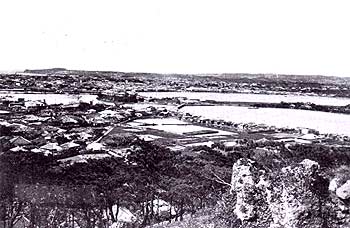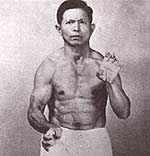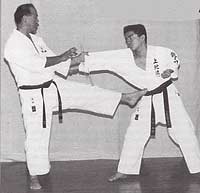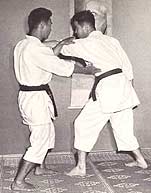Uechi-ryu Karate – A short History: Part 2
By Mario McKenna
Editor’s Note: This is the second
article in the history of Naha-Te (meaning Naha-hand, Naha referring
to the seaport city in Okinawa) Uechi-Ryu karate. Part
1 introduced the
style’s founder, Uechi Kanbun (1877-1948) and detailed trip to
mainland China to further his martial arts studies. Part 2 chronicles
his return to Okinawa and the development of his style of karate.
 |
Kanbun Uechi returned to Naha City, Okinawa (photo Ca.1990). This
teaming port city was known for its trading and rich mix of foreign
traders, sailors and visitors. Along with Uechi Ryu, other styles
also flourished eventually there which had their own distinct aspects
and reflected a more direct heritage from their Chinese roots. The
best known of this group was Goju ryu. |
Like his counterpart Higashionna Kanryo several decades earlier, after
his return to Okinawa Uechi Kanbun never talked about, or taught quan'fa
(Chinese martial arts). In fact, many potential students came to know
of Uechi Kanbun and sought him out, but Kanbun summarily dismissed them.
It was only after he moved to Wakayama prefecture in 1924, at the age
of 47 in search of better work to support his family that Kanbun was
finally convinced to start teaching quan'fa again (Okinawa Prefectural
Board of Education, 1997).
 |
Kanei Uechi (1910-1991), the son of the founder
of Uechi Ryu karate who inherited the system.
|
Kanbun taught full time, and also made and
sold the medicinal compounds as he had done when he lived in China
(Breyette, 1999). Three years later, in 1927, Kanbun's eldest son,
Uechi Kanei (1911-1991)
moved to Wakayama and began learning his father's system of quan'fa
(Okinawa Prefectural Board of Education, 1997). Around the time that Kanbun was teaching his brand of quan'fa in Wakayama
prefecture, the popularization and modernization of Okinawan karate had
begun. 'Toudi' (China hand) had now become (renamed) karate (empty hand).
During this boom-era of popularization a multitude of styles were named
and renamed. In contrast, Uechi Kanbun seemed reluctant to formally name
his system. Indeed, Uechi Kanbun never stated the name of the system
of quan'fa he studied in China and simply referred to his art as Pangainoon-ryu
karate-jutsu (Jap. Half hard / soft empty-hand technique); a name which
his students innocently mistook as a reference to his particular style
of karate.
During his time in Wakayama prefecture, many Okinawan karate teachers
visited Kanbun. Among them were Shito-ryu founder Mabuni Kenwa and Konishi
Yasuhiro of the Shindo Jinen Ryu. Mabuni was intensely curious as to
what had kept Uechi Kanbun in China for well over a decade and Kanbun
was more than happy to oblige by demonstrating some of the xing / kata
and techniques that comprised his ‘Pangainoon karate'. So inspired
was Mabuni by what Kanbun showed him, that Mabuni included some of the
basic Fujian tiger boxing techniques in a kata he later developed called
'Shinpa' or 'mind-wave.' Konishi, for his part, did not fair as well
as Mabuni. Konishi later recalled that Uechi was ‘living like a
recluse' and that he was unable to follow the conversation between Mabuni
and Uechi as Uechi Kanbun's Japanese was limited (McCarthy, 1999b). Instead,
the two Okinawans talked in ‘Okinawa hogen' (Okinawa dialect).
It should be noted that Pangainoon does not refer to a specific style
of quan'fa or Chinese boxing. Instead, it more likely refers to the mixture
of training methods from Fujian that Uechi Kanbun combined to make his
system of karate. In fact, Pangainoon refers to principles common to
all martial arts. These include: goho (Jap. Lit. ‘Hard method’),
juho (Jap. Lit. 'Flexible method’) and gojuho (Jap. Lit. ‘Hard
/ flexible method’). Examples of goho or hard method include: Tiger
boxing (Jap. Tora Ken), Great Ancestor boxing (Jap. Tai So Ken), and
Lion boxing (Jap. Shi Ken). Examples of gojuho or hard / flexible boxing
include: White crane (Jap. Haku Tsuru Ken) and examples of the Juho or
flexible method include: Shaolin Flower Boxing (Jap. Shorin Hana Ken),
and Crane boxing (Jap. Tsuru Ken).
 |
 |
Uechi Ryu Karate is a powerful, hard Okinawan style
that shares many similarities with Goju Ryu karate and the lesser
Naha-Te styles of To'on Ryu and Ryuei Ryu. Stances are mostly high,
such as the pigeon toe stance (rather than long and deep as some
Japanese styles). Techniques feature one knuckle punches, kicks
using the big toe (photo left), spear hand (photo right) that symbolically
refer to Tigers Teeth and Crane’s beak (moves emulating animal
fighting techniques). Also included are a variety of open and closed
hand techniques combined with angling and the use of circular blocks
and grabs. There were no closed fist punches, however, in the original
three kata of Uechi-ryu: Sanchin, Seisan and Sanseryu. Open hand
striking techniques emphasize (fingers and many other parts of
the hands) striking specific pressure points on the body. |
In 1940, Kanbun renamed his system Uechi-ryu Karate-jutsu (Uechi style
empty-hand technique). By 1947 Uechi Kanbun had returned to Okinawa and
moved to Ie Jima. He passed away the following year on November 25,1948.
The year after Kanbun's death, his son, Uechi Kanei returned to Okinawa
and opened his first dojo in Ginowan calling it ‘Uechi-ryu Karate-jutsu
Kenkyujo' or the Uechi-ryu Karate-jutsu Research Center (Okinawa Prefectural
Board of Education, 1997). There Kanei continued to teach his interpretation
of his father's art until he relocated his dojo to the city of Futenma
in the 1950's. After Uechi Kanei's passing in 1991 at the age of 79 Uechi-ryu
karate-do splintered into literally dozens of different organizations
each teaching their own interpretation of Uechi Kanbun's art.
Acknowledgements:
FightingArts.com would like to thank George Mattson for
use of a photo (worked on with Photoshop) from his book “The Way of Karate,” and
Alan Dollar for a photo from his article ”Uechi-Ryu Deadly Strikes” that
appeared in Bugeisha Magazine, Issue 2, March 1997
References:
Breyette, G. (1999). History of Uechi Ryu. http://www.fortunecity.com/olympia/brucelee/550/history.htm
Cook, H. (1999). Sanchin: Training for Power. Dragon Times, Vol. 13,
pp.34-36.
Dollar, A. (1996). Secrets of Uechi-ryu Karate and the Mysteries of
Okinawa. Antioch, California: Cherokee Publishing.
Kinjo, A. (1999). Karate Denshin Roku (A True Record of the Transmission
of Karate). Okinawa: Tosho Centre.
McCarthy, P. (1999). Fujian Quanfa. Archives section. International
Ryukyu Karate Research Society. http://202.139.244.45
McCarthy, P. (1999b). Ancient Okinawan Martial Arts: Koryu Uchinadi.
Vol. 2. Rutland, VT: C.E. Tuttle.
Okinawa Prefectural Board of Education. (1997). Karate Kobudo Kihon
Chousa Hokokushou (Karate Kobudo: A Basic Investigative Report). Vol.
2. Ginowan: Nansei.
About The Author:
Mario McKenna is a martial arts teacher, writer and historian who also
translates Japanese texts into English. He began his training under Yoshitaka
Kinjo sensei in 1985, while a high school student in Lethbridge, Alberta.
He moved to Japan in 1994 and while living on the island of Amami Oshima
in Kagoshima, Japan, he trained under Minowa Katsuhiko sensei and his
student Yoshimura Hiroshi sensei in classical Okinawan weaponry. In 1998
he began studying Tou'on-ryu from Kanzaki Shigekazu sensei until his
return to Canada in 2002. His qualifications include: Tou'on-ryu Karatedo
Go-dan (5th degree), Ryukyu Kobudo Yon-dan (4th degree), and Gohakukai
San-dan (3rd degree). Other martial arts experience includes limited
training in Aikido, Judo, Shorinji Kenpo, and 18 months of training in
Chikubishima-ryu bo-jutsu in Omura, Nagasaki Prefecture, Japan. He has
written on the historical and cultural aspects of martial arts training.
He now teaches Okinawan karate-do at his Kitsilano dojo in Vancouver,
B.C., Canada. Mario has previously contributed to FightingArts.com. His
website is: http://www.mariomckenna.com
|